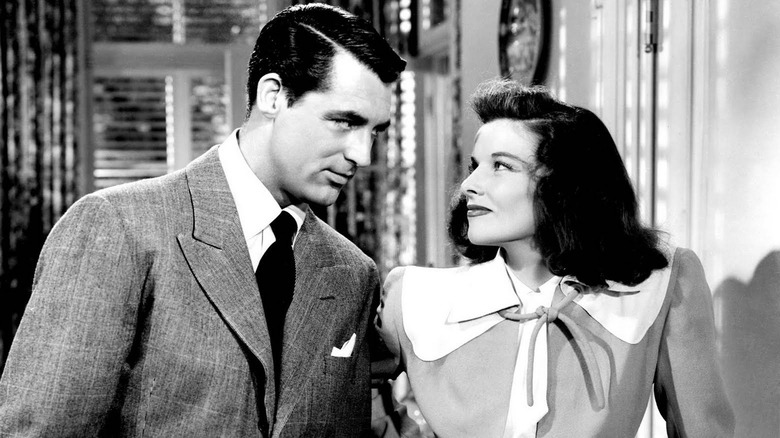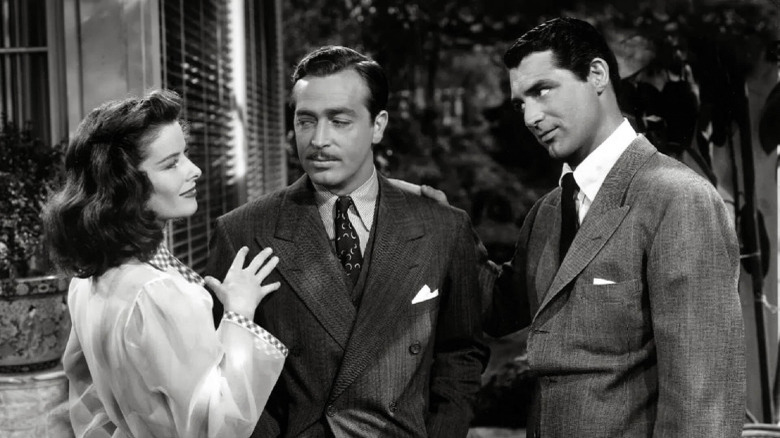The Philadelphia Story Scene You Probably Didn't Know Was Improvised
Possibly the best-known rom-com to come out of the Golden Age of Hollywood, "The Philadelphia Story" brought screen icons Katharine Hepburn, James Stewart, and Cary Grant together for a film that revitalized Hepburn's career after a string of box office duds. It would go on to snag a half-dozen Oscar nods (including one for Best Picture), ultimately taking home Academy Awards for Stewart's performance and Donald Ogden Stewart's script, adapted from Philip Barry's stage play. It's also a movie that maintains its charm 80 years on but comes off feeling rather problematic without the proper context — as my roommates and I were reminded upon deciding to stream it one night amidst the 2020 lockdowns.
Released in 1940, the film centers on Tracy Lord (Hepburn), a socialite whose plans to marry the wealthy George Kittredge (John Howard) are complicated when her ex-husband, C.K. Dexter Haven (Grant), shows up at her wedding with tabloid magazine reporter Macaulay "Mike" Connor (Stewart) and his photographer girlfriend Elizabeth "Liz" Imbrie (Ruth Hussey), who pretend to be friends of the family. What ensues is a comedy of errors that, as /Film's Hoai-Tran Bui has noted, "spends almost its entire runtime cutting [Tracy] down to size, with most of the characters, including her love interests, abusing her both verbally and once physically." The latter comes in when Dexter (er, hilariously?) shoves her down in the movie's opening scene.
Why, then, did someone as famously strong-willed and outspoken as Hepburn agree to make the movie? Well, before we get into that, let's talk about the dynamic between Hepburn and her co-stars, including their ability to mix things up via improvisation.
Stewart almost got Grant to crack
As mean as "The Philadelphia Story" and its male leads are to Tracy Lord, it's just as apparent that Hepburn, Grant, and Stewart got on quite well filming their shenanigans. Hepburn and Grant had already worked together on a handful of movies by the time "The Philadelphia Story" went into production, including Howard Hawks' now-classic screwball comedy "Bringing Up Baby." Indeed, the duo's fondness for one another shines through onscreen, even when their characters' interactions are anything but pleasant.
That goes double for Grant and Stewart. In the scene where a tipsy Mike tries to get Dexter to admit he's still in love with Tracy, Grant, clearly surprised, has to look away to stifle a smile the first time Stewart hiccups. That's because this bit wasn't pre-planned: Stewart improvised Mike's drunken hiccups for added realism and, of course, comedic effect. It worked, too, which is why this specific take made it into the movie's final cut in spite of Grant's visible struggle to avoid breaking character.
What's more, Stewart's turn as the cynical, boozing Mike was a notable change of pace for the actor — who, at the time, was best known for his good-natured and wholesome characters in movies like "Mr. Smith Goes to Washington." Stewart would go on to shed his "aw, shucks" persona in such films as "Vertigo," but his hijinks in "The Philadelphia Story" were an early showcase of his true range and versatility.
The story behind The Philadelphia Story
As for Hepburn, her desire to star in "The Philadelphia Story" makes more sense when you know what was going on in her career at that time. As I mentioned earlier, she was coming off a series of box office failures — some of which, most notably "Bringing Up Baby," have since been reclaimed by film buffs. This not only led to Hepburn being labeled "box office poison" by the Independent Theatre Owners of America, but it also resulted in public opinion turning against her with accusations that she was unlikeable and arrogant. (I'm sure you're shocked to learn the world being awful and unfair to women in the limelight isn't a purely modern phenomenon.)
Playwright Philip Barry wrote the original "Philadelphia Story" play specifically for Hepburn, who would go on to portray Tracy on Broadway (and back the production financially) before landing the film rights as a gift from her then-boyfriend Leonardo DiCaprio ... er, Howard Hughes. She then recruited her close friend George Cukor — who had already directed her in multiple films by that point, including her and Grant's 1938 rom-com "Holiday" (also based on a play by Barry) — and set up shop at MGM, knowing it would allow her the creative control she wanted.
In short: "The Philadelphia Story" was Hepburn's way of reclaiming the narrative around her and her career. By allowing the men on screen to insult and degrade her character, Hepburn was calling out her real-world detractors for placing her on a pedestal, then tearing her down for being human. That's not to say the film perfectly achieves its goals: It lets its male leads off way too easy for their entitlement, and its love for the upper class can be quite frustrating. But when you're aware of the historical context around the movie, it becomes a little easier to stomach the disrespect it shows its star— knowing that we are, in fact, meant to be on Tracy's side.

